The document provides an overview of object-oriented programming concepts and Java programming. It discusses key OOP concepts like abstraction, encapsulation, inheritance, polymorphism and classes. It then covers the history and development of Java, describing how it was initially created at Sun Microsystems to develop software for consumer electronics but was later targeted towards internet programming. The document also lists some of Java's key characteristics like being simple, secure, portable, object-oriented, robust and multithreaded.
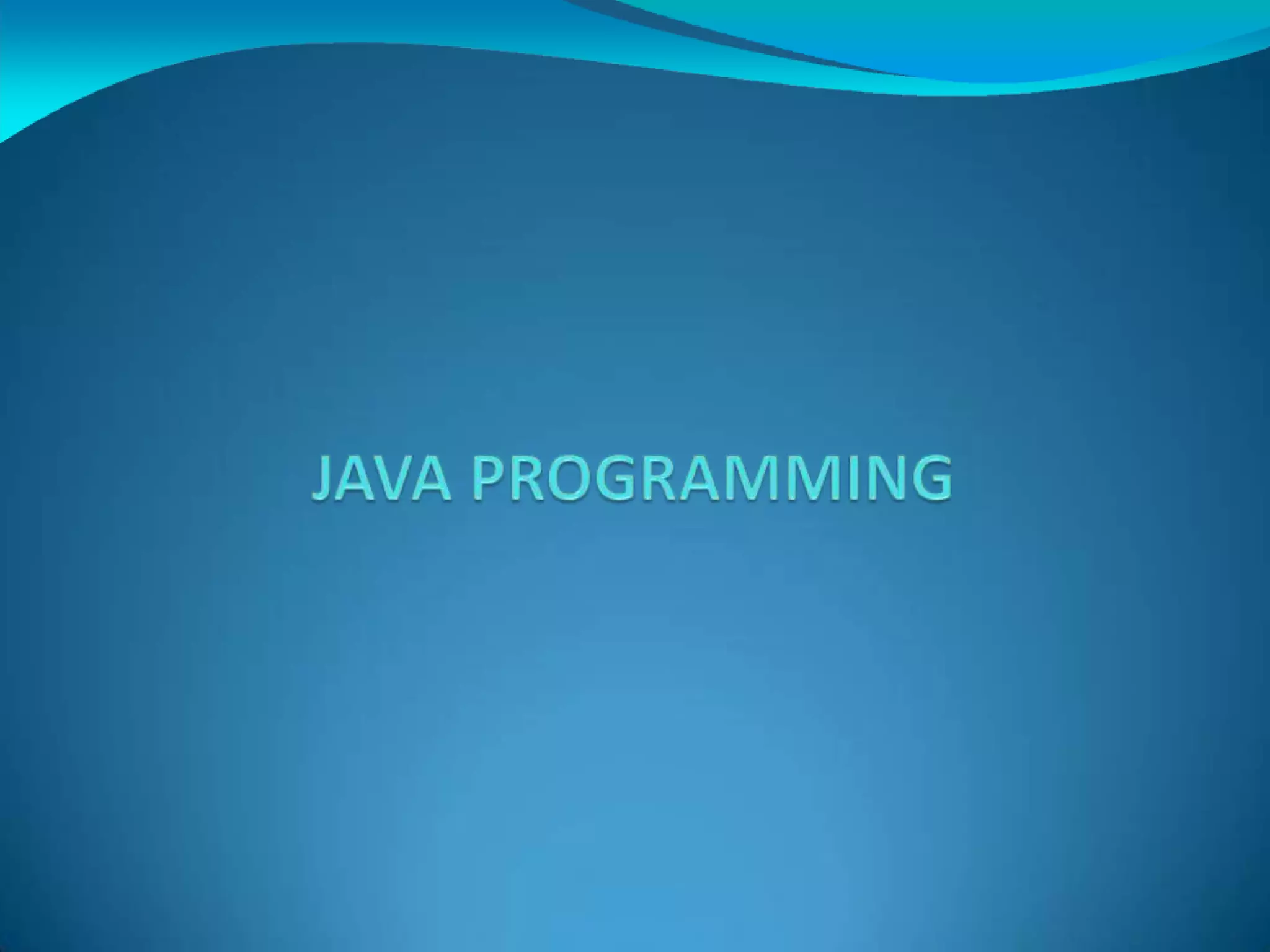




















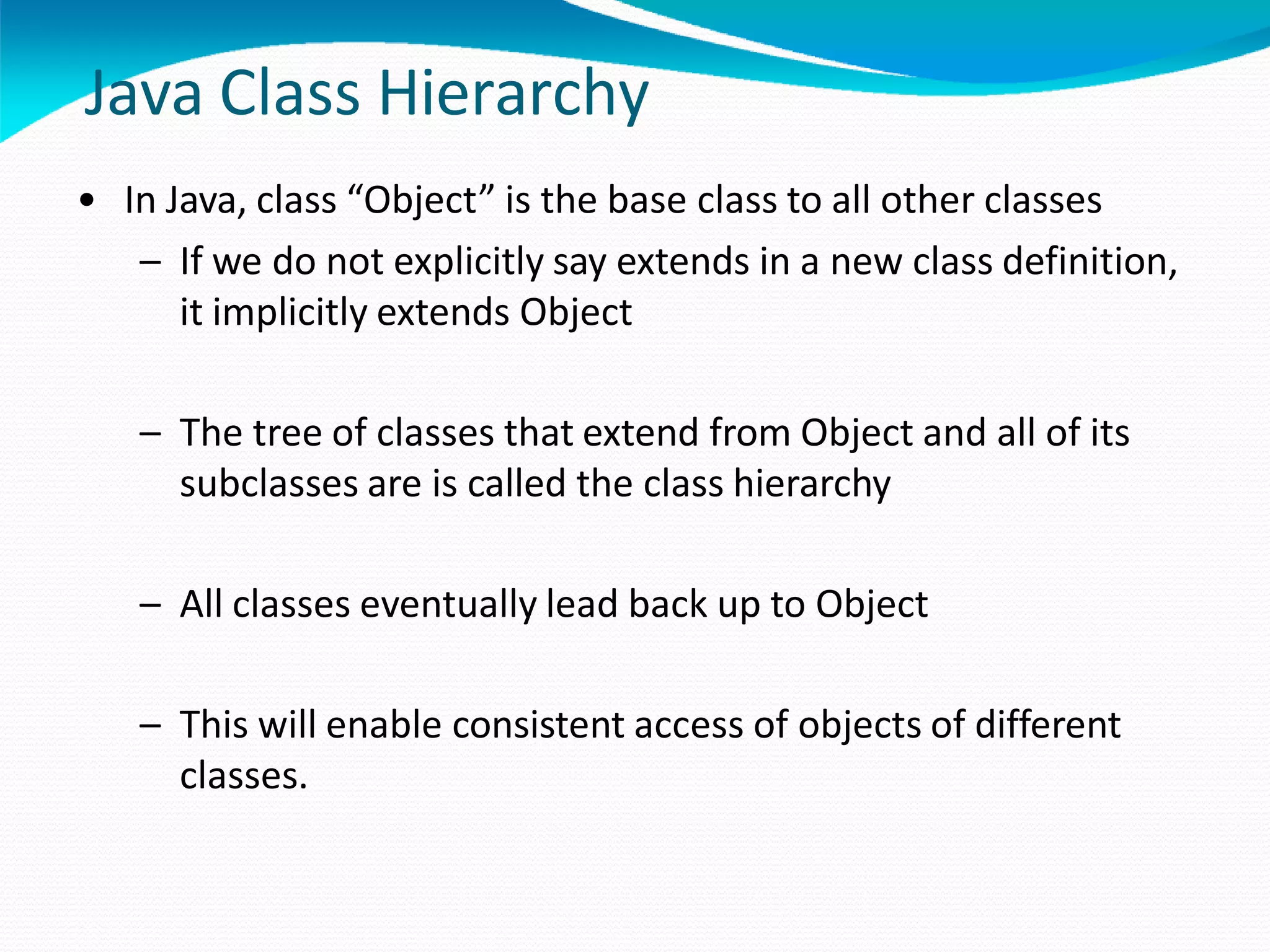














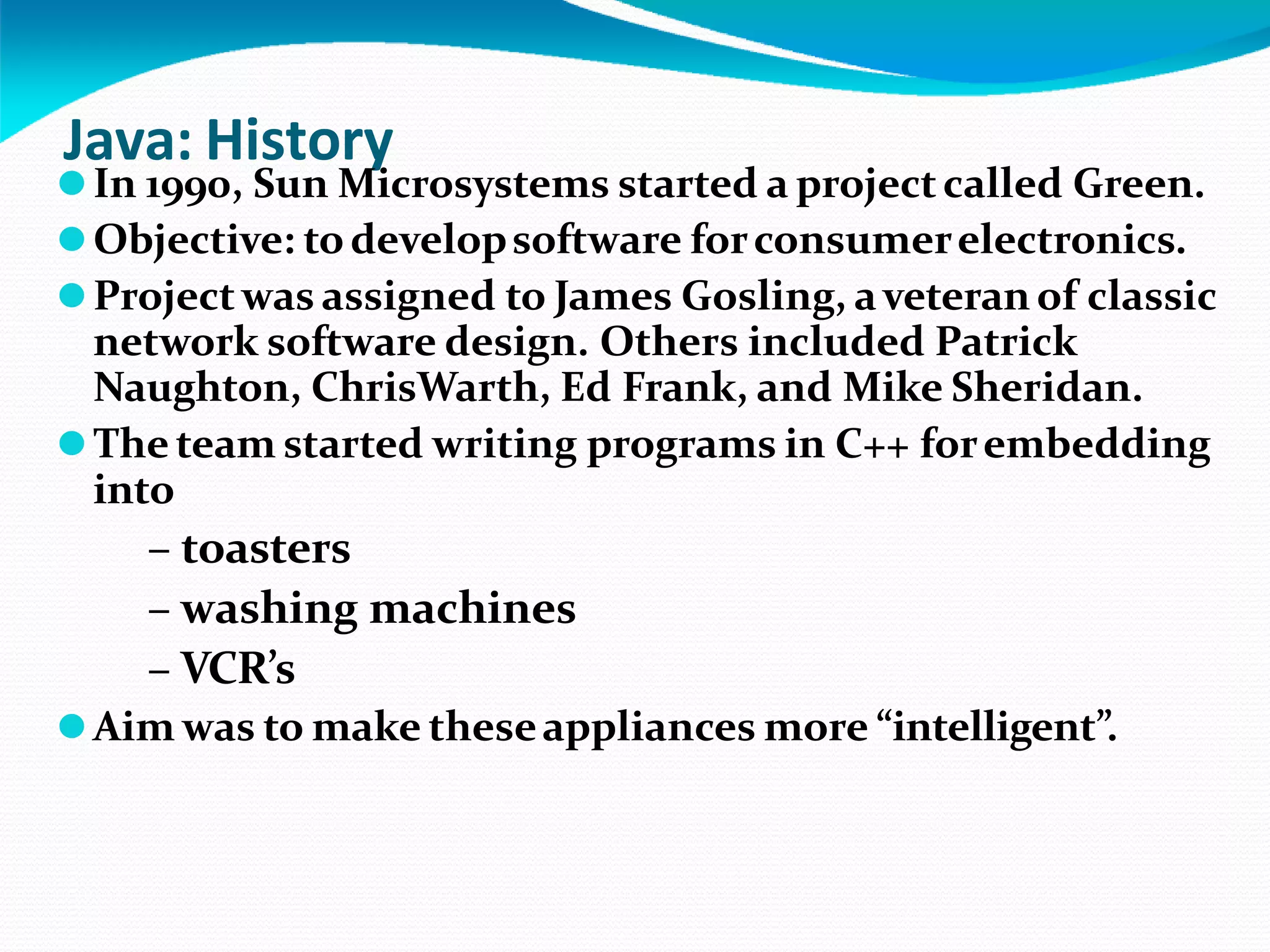

















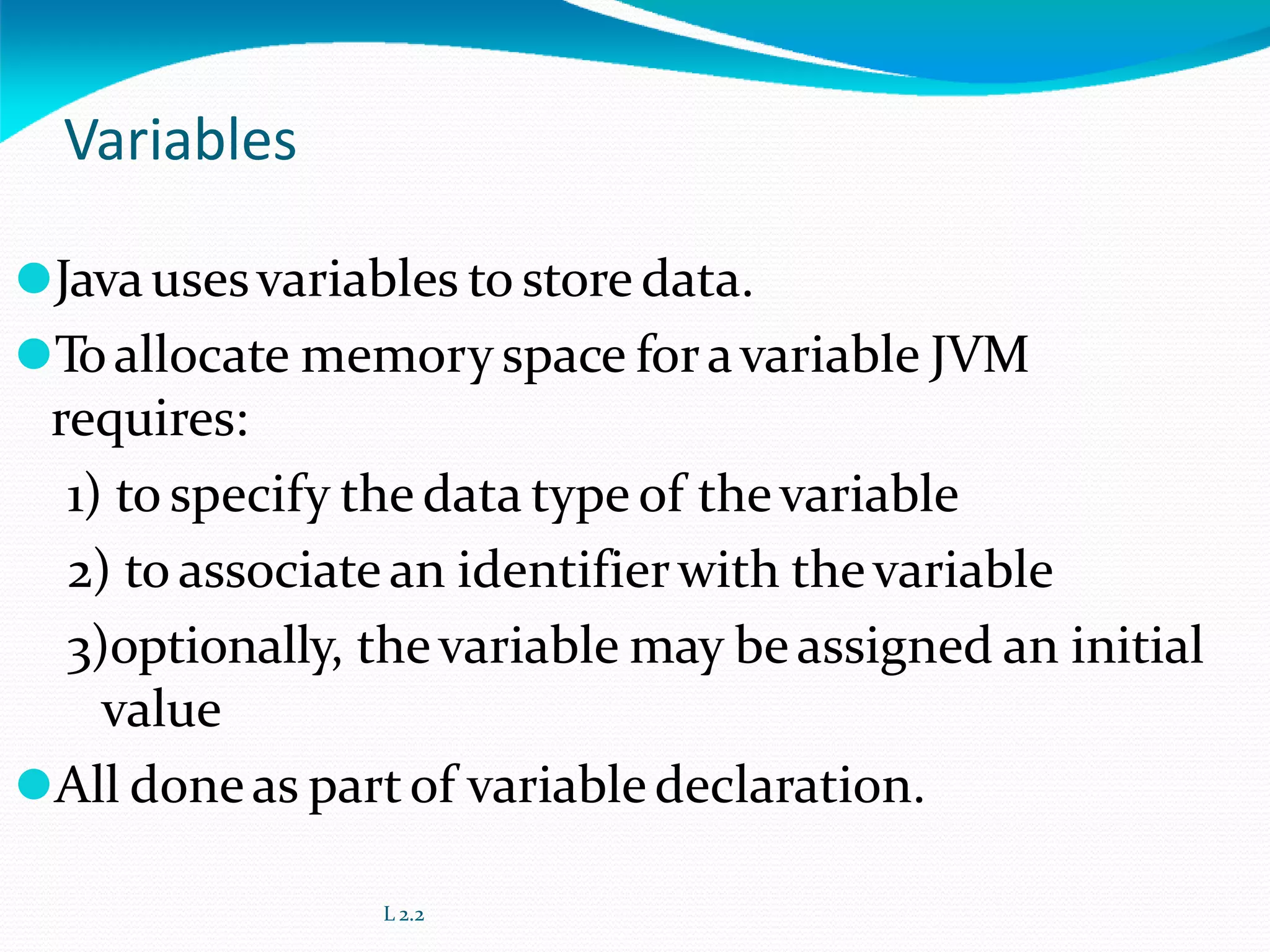
![Basic Variable Declaration
⚫datatype identifier [=value];
⚫datatype must be
⚫A simpledatatype
⚫Userdefined datatype (class type)
⚫Identifier is a recognizable nameconfirm to identifier
rules
⚫Value is an optional initial value.](https://image.slidesharecdn.com/java-ppts-230214063445-3548cf42/75/JAVA-PPT-S-pptx-56-2048.jpg)
![Variable Declaration
⚫Wecan declare several variables at the same time:
type identifier [=value][, identifier [=value] …];
Examples:
inta, b, c;
intd = 3, e, f = 5;
byteg = 22;
double pi = 3.14159;
charch = 'x';
L 2.4](https://image.slidesharecdn.com/java-ppts-230214063445-3548cf42/75/JAVA-PPT-S-pptx-57-2048.jpg)



![Array Declaration
⚫Arraydeclaration involves:
1) declaring an array identifier
2) declaring the numberof dimensions
3) declaring thedata type of the array elements
⚫Twostyles of array declaration:
typearray-variable[];
or
type [] array-variable;
L 2.8](https://image.slidesharecdn.com/java-ppts-230214063445-3548cf42/75/JAVA-PPT-S-pptx-61-2048.jpg)
![Array Creation
⚫Afterdeclaration, noarray actuallyexists.
⚫In order tocreatean array, weuse the new
operator:
typearray-variable[];
array-variable = new type[size];
⚫Thiscreates a new array to hold size elementsof
type type, which reference will be kept in the
variablearray-variable.](https://image.slidesharecdn.com/java-ppts-230214063445-3548cf42/75/JAVA-PPT-S-pptx-62-2048.jpg)
![Array Indexing
⚫Laterwecan refer to the elementsof thisarray through
their indexes:
⚫array-variable[index]
⚫The array index always starts with zero!
⚫The Java run-time system makes sure that all array
indexesare in the correct range, otherwise raises a run-
timeerror.](https://image.slidesharecdn.com/java-ppts-230214063445-3548cf42/75/JAVA-PPT-S-pptx-63-2048.jpg)
![Array Initialization
⚫Arrays can be initialized when theyare declared:
⚫int monthDays[] = {31,28,31,30,31,30,31,31,30,31,30,31};
⚫Note:
1) there is no need touse the new operator
2)thearray iscreated large enough to hold all specified
elements](https://image.slidesharecdn.com/java-ppts-230214063445-3548cf42/75/JAVA-PPT-S-pptx-64-2048.jpg)
![Multidimensional Arrays
⚫Multidimensional arrays are arrays of arrays:
intarray[][];
intarray = new int[2][3];
1) declaration:
2) creation:
3) initialization
intarray[][] = { {1, 2, 3}, {4, 5, 6} };](https://image.slidesharecdn.com/java-ppts-230214063445-3548cf42/75/JAVA-PPT-S-pptx-65-2048.jpg)






![⚫An expression is a construct made up of variables,
operators, and method invocations, which are
constructed according to the syntax of the language, that
evaluates to a single value.
⚫Examples of expressions are in bold below:
int number = 0;
anArray[0] = 100;
System.out.println ("Element 1 at index 0: " +
anArray[0]);
int result = 1 + 2; // result is now 3 if(value1 ==
value2)
System.out.println("value1 == value2");
L 2.19
Expressions](https://image.slidesharecdn.com/java-ppts-230214063445-3548cf42/75/JAVA-PPT-S-pptx-72-2048.jpg)










![Simple Java Program
⚫A class todisplaya simple message:
class MyProgram
{
public staticvoid main(String[] args)
{
System.out.println(“First Javaprogram.");
}
}](https://image.slidesharecdn.com/java-ppts-230214063445-3548cf42/75/JAVA-PPT-S-pptx-83-2048.jpg)






![Example: Class Usage
class Box {
doublewidth;
double height;
doubledepth;
}
class BoxDemo {
public staticvoid main(String args[]) {
Box mybox = new Box();
doublevol;
mybox.width = 10;
mybox.height = 20;
mybox.depth = 15;
vol = mybox.width * mybox.height * mybox.depth;
System.out.println ("Volume is " + vol);
} }](https://image.slidesharecdn.com/java-ppts-230214063445-3548cf42/75/JAVA-PPT-S-pptx-90-2048.jpg)












![⚫The String class containsseveral methods thatyou can use.
Here are a few
. You can
⚫test twostrings forequality by using
equals( ). Youcan obtain the length of a string bycalling the
length( ) method. Youcan obtain the character ata specified
index within a string by calling charAt( ). The general forms
of these three methodsare shown here:
⚫// Demonstrating some String methods.
class StringDemo2 {
public staticvoid main(String args[]) {
String strOb1 = "First String";
String strOb2 = "Second String";
String strOb3 = strOb1;
System.out.println("Length of strOb1: " +
strOb1.length());](https://image.slidesharecdn.com/java-ppts-230214063445-3548cf42/75/JAVA-PPT-S-pptx-103-2048.jpg)















































![Example: Super and Hiding
⚫Although the i variable in B hides the i variable in A,
superallows access to the hidden variable of the
super-class:
class UseSuper {
public staticvoid main(String args[]) {
B subOb = new B(1, 2);
subOb.show();
}
}](https://image.slidesharecdn.com/java-ppts-230214063445-3548cf42/75/JAVA-PPT-S-pptx-151-2048.jpg)








![Example: Hiding with Overriding 3
⚫When show() is invoked on an objectof type B,
theversion of show() defined in B is used:
class Override {
publicstaticvoid main(String args[]) {
B subOb = new B(1, 2, 3);
subOb.show();
}
}
⚫Theversion of show() in A is hidden through
overriding.](https://image.slidesharecdn.com/java-ppts-230214063445-3548cf42/75/JAVA-PPT-S-pptx-160-2048.jpg)














![Example: Package
class AccountBalance
{
publicstatic void main(String args[])
{
Balancecurrent[] = new Balance[3];
current[0] = new Balance("K. J. Fielding", 123.23);
current[1] = new Balance("Will Tell", 157.02);
current[2] = new Balance("Tom Jackson", -12.33);
for (int i=0; i<3; i++) current[i].show();
}
}](https://image.slidesharecdn.com/java-ppts-230214063445-3548cf42/75/JAVA-PPT-S-pptx-175-2048.jpg)




![Example: Packages 2
The importing code has access to the publicclass Balanceof
the
MyPack package and its two public members:
import MyPack.*;
class TestBalance {
publicstaticvoid main(String args[]) {
Balance test = new Balance("J. J. Jaspers", 99.88);
test.show();
}
}](https://image.slidesharecdn.com/java-ppts-230214063445-3548cf42/75/JAVA-PPT-S-pptx-180-2048.jpg)
















![Example: Interface Variables 4
⚫The testing function relies on the fact that both ask and
answer methods.
⚫defined in differentclasses, relyon thesameconstants:
publicstaticvoid main(String args[]) {
Questionq = new Question();
answer(q.ask());
answer(q.ask());
answer(q.ask());
answer(q.ask());
}
}](https://image.slidesharecdn.com/java-ppts-230214063445-3548cf42/75/JAVA-PPT-S-pptx-197-2048.jpg)



![Example: Interface Inheritance 3
⚫Createa new MyClassobject, then invoke all interface
methods on it:
class IFExtend {
publicstaticvoid main(String arg[]) {
MyClassob = new MyClass();
ob.meth1();
ob.meth2();
ob.meth3();
}
}](https://image.slidesharecdn.com/java-ppts-230214063445-3548cf42/75/JAVA-PPT-S-pptx-201-2048.jpg)







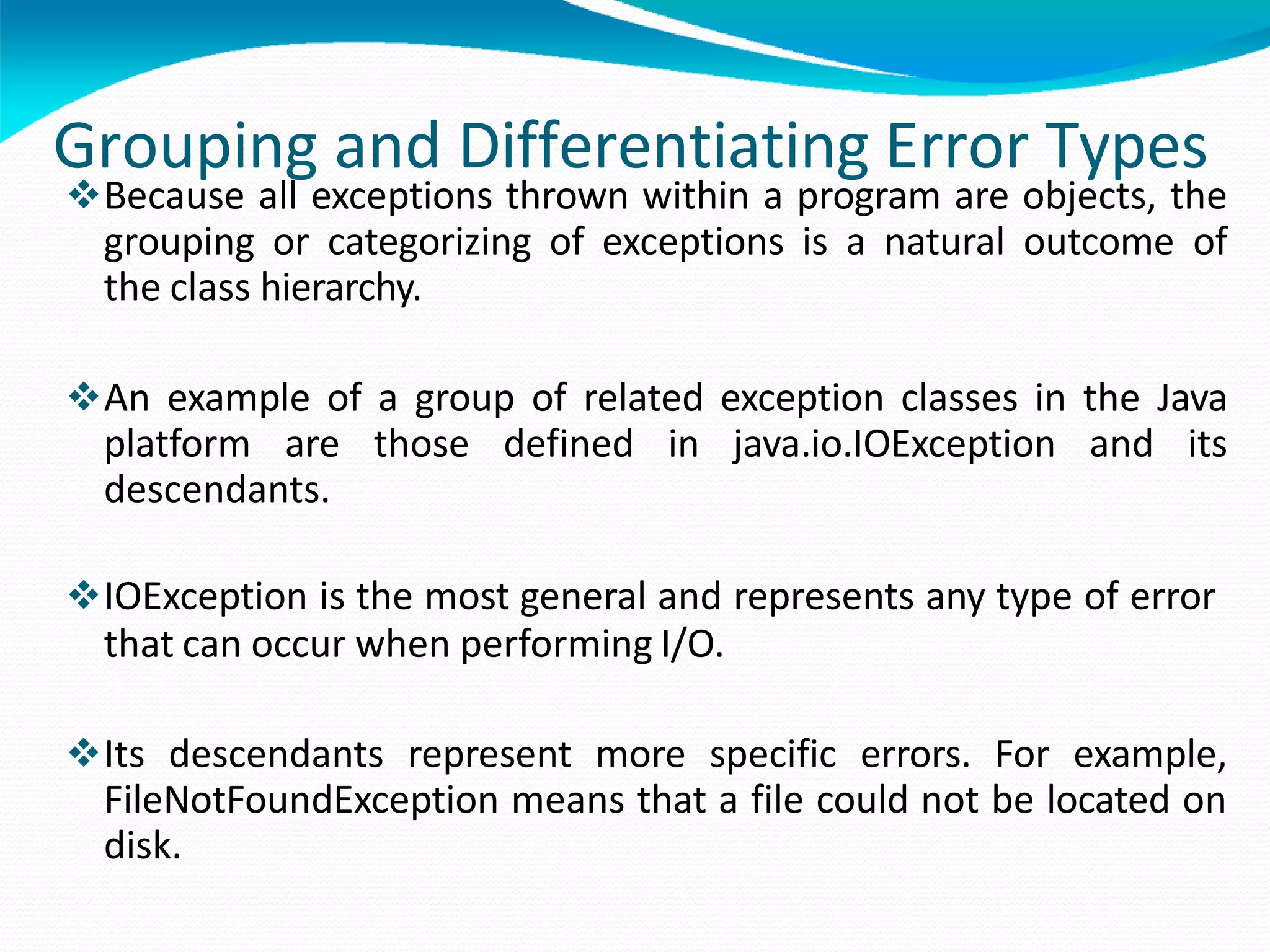






![Catching Exceptions:
The try-catch Statements
class DivByZero {
public static void main(String args[]) {
try {
System.out.println(3/0);
System.out.println(“Please print me.”);
} catch (ArithmeticException exc) {
//Division by zero is an ArithmeticException
System.out.println(exc);
}
System.out.println(“After exception.”);
}
}](https://image.slidesharecdn.com/java-ppts-230214063445-3548cf42/75/JAVA-PPT-S-pptx-216-2048.jpg)
![Catching Exceptions:
Multiple catch
class MultipleCatch {
public static void main(String args[]) {
try {
int den = Integer.parseInt(args[0]);
System.out.println(3/den);
} catch (ArithmeticException exc) {
System.out.println(“Divisor was 0.”);
} catch (ArrayIndexOutOfBoundsException exc2) {
System.out.println(“Missingargument.”);
}
System.out.println(“After exception.”);
}
}](https://image.slidesharecdn.com/java-ppts-230214063445-3548cf42/75/JAVA-PPT-S-pptx-217-2048.jpg)
![Catching Exceptions:
Nested try's
class NestedTryDemo {
public static void main(String args[]){
try {
int a = Integer.parseInt(args[0]);
try {
int b = Integer.parseInt(args[1]);
System.out.println(a/b);
} catch (ArithmeticException e) {
System.out.println(“Div by zero error!");
} } catch (ArrayIndexOutOfBoundsException) {
System.out.println(“Need 2 parameters!");
} } }](https://image.slidesharecdn.com/java-ppts-230214063445-3548cf42/75/JAVA-PPT-S-pptx-218-2048.jpg)
![Catching Exceptions:
Nested try's with methods
class NestedTryDemo2 {
static void nestedTry(String args[]) {
try {
int a = Integer.parseInt(args[0]);
int b = Integer.parseInt(args[1]);
System.out.println(a/b);
} catch (ArithmeticException e) {
System.out.println("Div by zero error!");
} }
public static void main(String args[]){
try {
nestedTry(args);
} catch (ArrayIndexOutOfBoundsException e) {
System.out.println("Need 2 parameters!");
} } }](https://image.slidesharecdn.com/java-ppts-230214063445-3548cf42/75/JAVA-PPT-S-pptx-219-2048.jpg)



![Example: throw 2
The main method calls demoproc within the try block
which catches and handles the NullPointerException
exception:
public static void main(String args[]) {
try {
demoproc();
} catch(NullPointerException e) {
System.out.println("Recaught: " + e);
}
}
}](https://image.slidesharecdn.com/java-ppts-230214063445-3548cf42/75/JAVA-PPT-S-pptx-223-2048.jpg)

![Example: throws 1
⚫The throwOne method throws an exception that it does not
catch, nor declares it within the throws clause.
class ThrowsDemo {
static void throwOne() {
System.out.println("Inside throwOne.");
throw new IllegalAccessException("demo");
}
public static void main(String args[]) {
throwOne();
}
}
⚫Therefore this program does not compile.](https://image.slidesharecdn.com/java-ppts-230214063445-3548cf42/75/JAVA-PPT-S-pptx-225-2048.jpg)
![Example: throws 2
⚫Corrected program: throwOne lists exception, main catches it:
class ThrowsDemo {
static void throwOne() throws IllegalAccessException {
System.out.println("Inside throwOne.");
throw new IllegalAccessException("demo");
}
public static void main(String args[]) {
try {
throwOne();
} catch (IllegalAccessException e) {
System.out.println("Caught " + e);
} } }](https://image.slidesharecdn.com/java-ppts-230214063445-3548cf42/75/JAVA-PPT-S-pptx-226-2048.jpg)





![Example: finally 4
⚫ Demonstration of the three methods:
public static void main(String args[]) { try {
procA();
} catch (Exception e) {
System.out.println("Exception caught");
}
procB();
procC();
}
}](https://image.slidesharecdn.com/java-ppts-230214063445-3548cf42/75/JAVA-PPT-S-pptx-232-2048.jpg)




![Example: Own Exceptions 1
⚫A new exception class is defined, with a private detail
variable, a one parameter constructor and an overridden
toString method:
class MyException extends Exception {
private int detail;
MyException(int a) {
detail = a;
}
public String toString() {
return "MyException[" + detail + "]";
}
}](https://image.slidesharecdn.com/java-ppts-230214063445-3548cf42/75/JAVA-PPT-S-pptx-237-2048.jpg)

![Example: Own Exceptions 3
The main method calls compute with two arguments within a try
block that catches the MyException exception:
public static void main(String args[]) {
try {
compute(1);
compute(20);
} catch (MyException e) {
System.out.println("Caught " + e);
}
}
}](https://image.slidesharecdn.com/java-ppts-230214063445-3548cf42/75/JAVA-PPT-S-pptx-239-2048.jpg)











![Example: New Thread 3
class ThreadDemo {
public static void main(String args[]) {
//A new thread is created as an object of
// NewThread:
new NewThread();
//After calling the NewThread start method,
// control returns here.](https://image.slidesharecdn.com/java-ppts-230214063445-3548cf42/75/JAVA-PPT-S-pptx-251-2048.jpg)




![Example: New Thread 3
class ExtendThread {
public static void main(String args[]) {
//After a new thread is created:
new NewThread();
//the new and main threads continue
//concurrently…](https://image.slidesharecdn.com/java-ppts-230214063445-3548cf42/75/JAVA-PPT-S-pptx-256-2048.jpg)



















































































































































![JFrame
publicclass FrameTest {
public staticvoid main (String args[]) {
JFrame f = new JFrame ("JFrame Example");
Containerc = f.getContentPane();
c.setLayout(new FlowLayout());
for (int i = 0; i < 5; i++) {
c.add (new JButton ("No"));
c.add (new Button ("Batter"));
}
c.add (new JLabel ("Swing"));
f.setSize (300, 200);
f.show();
}
}](https://image.slidesharecdn.com/java-ppts-230214063445-3548cf42/75/JAVA-PPT-S-pptx-404-2048.jpg)












![Tables
⚫ A table is a component that displays rows and columns of data. You can drag
thecursoron column boundaries to resizecolumns. You can alsodrag a column
toa new position.
⚫ Tablesare implemented by the JTable class, whichextends JComponent.
⚫ Oneof its constructors is :
JTable(Objectdata[ ][ ], ObjectcolHeads[ ])
⚫ Here, data is a two-dimensional arrayof the information to be presented, and
colHeads is aone-dimensional arraywith the column headings.
⚫ Hereare the steps for using a table in an applet:
1. Createa JTable object.
2. Createa JScrollPaneobject. (Thearguments to the constructorspecify
the tableand
the policies forvertical and horizontal scroll bars.)
3. Add the tableto the scroll pane.
4. Add the scroll pane to the content pane of the applet.](https://image.slidesharecdn.com/java-ppts-230214063445-3548cf42/75/JAVA-PPT-S-pptx-417-2048.jpg)